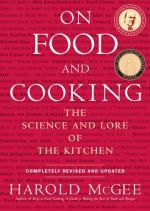|
This section contains 374 words (approx. 1 page at 400 words per page) |

|
Eggs Summary and Analysis
The egg is made from a living germ cell, which matures and grows a yellow yolk, full of fats and proteins. The yolk passes through the oviduct and is coated in a whitish membrane of protein cells. An air pocket is left as the egg is then coated in calcium carbonate and protein to form a shell. The yolk of the egg is the nutrition portion, and carries iron, thiamine, vitamin A, proteins and lipoproteins. The white consists of water and protein, and traces of minerals, fatty material, vitamins and glucose.
Eggs can be cooked in a number of ways. This includes eggs cooked in the shell, although the author recommends not boiling eggs. He states that to hard boil an egg, the water temperature must be far above that needed for protein coagulation, meaning that the white of the egg...
(read more from the Eggs Summary)
|
This section contains 374 words (approx. 1 page at 400 words per page) |

|




